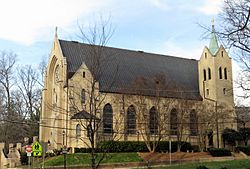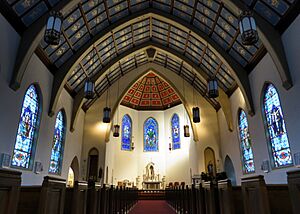Cathedral of Saint Patrick (Charlotte, North Carolina) facts for kids
Quick facts for kids Cathedral of Saint Patrick |
|
|---|---|

Side view of the Cathedral
|
|
| 35°12′20″N 80°50′44″W / 35.2055°N 80.8456°W | |
| Location | 1621 Dilworth Road East Charlotte, North Carolina |
| Country | |
| Denomination | Roman Catholic Church |
| History | |
| Founded | 1938 |
| Consecrated | September 4, 1939 |
| Architecture | |
| Architect(s) | Frank Frimmer |
| Style | Neo-Gothic |
| Groundbreaking | 1938 |
| Completed | 1939 |
| Specifications | |
| Materials | Limestone |
| Administration | |
| Diocese | Charlotte |
The Cathedral of Saint Patrick is an important Catholic church in Charlotte, North Carolina, in the United States. It is the main church for the Diocese of Charlotte, which means it's where the bishop of the area has his special chair and leads services. It's like the "mother church" for all the Catholic churches in the Charlotte area.
In 1987, this beautiful cathedral became part of the Dilworth Historic District. This district is listed on the National Register of Historic Places, which means it's a special place recognized for its history.
As of August 2025, the Very Reverend Peter Ascik is the main priest, called the rector, of St. Patrick Cathedral.
Contents
History of the Cathedral
Building the Church
Work on St. Patrick began on March 17, 1938. It started as a smaller "mission church" in Charlotte. The money for building it was given by John Henry Phelan to honor his parents. Frank Frimmer, an architect from Austria, was chosen to design the church.
Becoming a Consecrated Church
St. Patrick was officially dedicated on September 4, 1939. Bishop Eugene J. McGuinness from the Diocese of Raleigh led the ceremony. This made it the first church in North Carolina to be consecrated after it was finished.
Growing as a Parish
In 1941, a house for the priests (called a rectory) and a building for nuns (a convent) were added. In 1942, the Diocese made St. Patrick a full parish, which is a local church community. Monsignor Arthur R. Freeman became its first pastor.
Becoming a Cathedral
In 1972, Pope Paul VI created the Diocese of Charlotte. He chose St. Patrick Church to be its main church, or cathedral. Monsignor Richard Allen was then named the first rector of the new cathedral.
Major Renovations and Changes
St. Patrick had a big renovation in 1979 and was closed for six months. The original main altar was replaced with a new one that stood freely. The church also added new artwork that was important to the local area and to the faith. In June 1979, Bishop Michael J. Begley led the celebration for St. Patrick's reopening.
In 1996, the church moved the altar, the baptismal font (where baptisms happen), statues, and the ambo (where readings are given). They also put in a new hardwood floor. Dark wood panels that were added in 1979 were removed to make the inside look more like it did in 1939.
New Additions and Updates
A permanent copper roof was put on the church in 2000. In 2007, a large 700-pound bell was installed in the bell tower. This bell was actually made way back in 1875 in St. Louis, Missouri. A family life center, which is a building for church activities, was added to the church grounds in 2008.
In 2012, another renovation moved the tabernacle (where the Eucharist is kept), the cathedra (the bishop's chair), and the ambo. Marble benches and decorations were removed from the back wall of the sanctuary. The cover on the baptismal font was also restored.
In 2013, a new main entrance with two staircases was built. A special Celtic cross was placed on the railing. A Marian prayer grotto, which is a small cave-like area for prayer to the Virgin Mary, was built on the cathedral grounds in 2014.
In 2024, the diocese announced plans to build a new, larger cathedral to replace St. Patrick in the future.
What's Inside? Architectural Features
St. Patrick has a gray outside made of stucco. Inside, the main seating area, called the nave, can hold 400 people. There is also a balcony and a tall tower that is 77 feet (about 23.7 meters) high. The church has two smaller chapels on the sides, which are special places for prayer dedicated to the Blessed Virgin Mary and Saint Joseph. The church ceiling has 300 tiles.
Stained Glass and Relics
The beautiful stained glass windows were designed in Syracuse, New York. They show important religious scenes and figures, like the Annunciation (when an angel told Mary she would have Jesus), Saint Patrick, Saint Joseph's death, King David playing his lyre, Saint Cecilia, and different events from the life of Jesus. The main altar holds special items called relics, which are small pieces connected to Saint Jucundius and Saint Justina.
The Pipe Organ
The large pipe organ is located in the balcony. It was designed and built by W. Zimmer and Sons from Fort Mill, South Carolina. This organ replaced the church's original Moller pipe organ.
See also
 In Spanish: Catedral de San Patricio (Charlotte) para niños
In Spanish: Catedral de San Patricio (Charlotte) para niños




